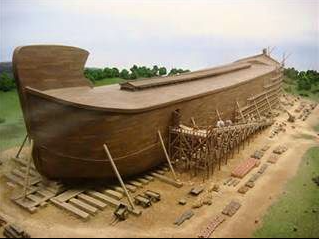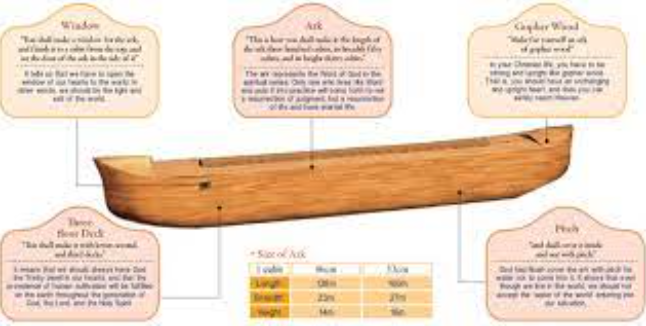In the preparation for the Flood, God is giving the people ample opportunity.
Genesis 6:14-16 KJV
[14] Make thee an ark of gopher wood; rooms shalt thou make in the ark, and shalt pitch it within and without with pitch.
[15] And this is the fashion which thou shalt make it of: The length of the ark shall be three hundred cubits, the breadth of it fifty cubits, and the height of it thirty cubits.
[16] A window shalt thou make to the ark, and in a cubit shalt thou finish it above; and the door of the ark shalt thou set in the side thereof; with lower, second, and third stories shalt thou make it.

Genesis 6:14
Make thee an ark of gopher wood; rooms shalt thou make in the ark, and shalt pitch it within and without with pitch.
Having warned Noah of the impending flood, God now tells him how to survive it. Notably, God’s instructions require Noah to demonstrate faith.
While God could miraculously protect Noah and his household inside a magic underwater bubble, He instead requires Noah to create his own means of survival at his own expense long before the first drop of rain falls.
Noah’s salvation is to take the form of a boat—an ark. The Hebrew word used to describe the vessel is somewhat unusual, appearing in the Bible only here in the story of Noah and at Exodus 2:3–5.
In the latter, it refers to the container in which Moses’ mother set him afloat on the Nile River. Some commentators think the word, deriving from an Egyptian term, means, chest or box; others think it means, palace.
In Noah’s context, it perhaps implies the special role the ark will play as a container of the precious life within. This was a hollow chest, a box designed to float on water, made of gopher-wood.
Probably cedar or cypress trees are in view, abundant in the mountains of Armenia. The precise kind of wood is uncertain since the word gopher is not a translation but a transliteration, that is, a literal rendering of the sounds of the original Hebrew word.
The fact that this is the only place in the Old Testament where this word is used adds to the uncertainty. “Make thee an ark of gopher wood.” Gopher wood is an almost indestructible wood very much like our redwood in California. “Rooms shalt thou make in the ark.” The word for “rooms” has the idea of nest.
The elephant would need a room, but the mole would not need quite that much space. He could be given just a little dirt in a corner, and that is all he would need. “And shalt pitch it within and without with pitch.” The ark was to be made waterproof.
In the previous verse, God revealed to Noah that He would destroy all of humanity for their violence. What other details were given, we don’t know. For our purposes, this is all Scripture has revealed.
Now, God launches into specific instructions to Noah, describing exactly how to build the ark. Once again, what’s recorded here in the Bible is not likely a complete transcript of God’s discussions with Noah.
Rather, it tells us the bare-bones basics of what this man is learning from God. Even with the instructions to follow, the text does not provide every detail needed to complete the construction of an ark.
It does show us, though, that God’s directions to Noah were very specific. God cared that Noah execute the construction of this craft according to God’s particular plan.
Strictly speaking, God does not tell Noah to build a boat. He tells Noah to build an ark. It’s possible that the word ark meant “box” or “chest.” This same term is used to describe the vessel used to carry the Ten Commandments by Israel after leaving Egypt (Exodus 25:10–16).
In reference to the “ark” built by Noah, there is no mention made of sails, or oars, or a rudder. This craft is meant to float, not travel. The dimensions given to Noah in the following verses describe a giant rectangular box.
At one point in history, skeptics laughed at the idea of such a craft being seaworthy. Now, however, the proportions of large cargo ships are extremely similar to the outlines of Noah’s ark.
Noah is told to build it with gopher wood, a material we aren’t entirely sure of. Some scholars believe this is actually a reference to cedar, or cypress, while others think it might be from a now-extinct tree.
Either way, it’s a substance appropriate for a craft built for this purpose. Furthermore, Noah is directed to make rooms (or “nests”) inside the ark, as well as to seal the spaces between the wood with pitch both inside and outside of the structure.
It should be noted that, in the context of the story, it’s unlikely that Noah was expected to build this ark only using his own two hands.
Just as the owner of a company can be said to have “built” something, when much of the labor is done by others, it seems reasonable to assume Noah used the help of his sons, and probably others, to construct this ark.

Genesis 6:15
And this is the fashion which thou shalt make it of: The length of the ark shall be three hundred cubits, the breadth of it fifty cubits, and the height of it thirty cubits.
The dimensions of the ark are impressive, even by modern standards: conversion of 18-inch cubits to feet yields a length of 450 feet, a breadth, or width of 75 feet, and height of 45 feet.
At first glance, the 33,750 square feet of floor space is impressive enough, but Genesis 6:16b, has more to add to this.
The total volume computes to more than 1.5 million cubic feet. This equates to the capacity of about 375 modern tractor trailers! Note that Noah’s ark is conceived as a free-floating barge, not as a steerable ship.
Therefore none of its capacity will be occupied by any kind of propulsion system. The impression that most people have of the ark is the impression they were given by the little Sunday school pictures which made it look like a houseboat.
It was, to me, a very ridiculous sort of a travesty. It was a caricature of the ark instead of a picture of it like it actually was.
To begin with, the instructions for the building of the ark reveal that it was quite sizable. “The length of the ark shall be three hundred cubits.” If a cubit is eighteen inches, that ought to give you some conception of how long this ark was.
The question arises as to how they could make it substantial in that day. My fellow Christian Siblings, we are not dealing with cavemen. We are dealing with a very intelligent man.
You see, the intelligence that the race has today came right through Noah, and he happened to be a very intelligent man. Noah is not making an oceangoing ship to withstand fifty-foot waves.
All he is building is a place for life, animal life and man, to stay over quite a period of time—not to go through a storm, but just to wait out the Flood. For that reason, the ark might lack a great deal that you would find on an oceangoing ship, and that would give it a great deal more room.
If a cubit is 18 inches, 300 cubits would mean that the ark was 450 feet long. That is a pretty long boat, but the relative measurements is the thing that interests me.
For instance, I noted that the New Mexico, one of our battleships of the World War II era, was built 624 feet long, 106¼ feet wide, and with a mean draught of 29½ feet.
By comparison the ark had practically the same ratio; so that you did not have a ridiculous looking boat at all. But one which would compare favorably with the way they build ships today.
In this passage, God has informed Noah of His plan to destroy the entire human race, except for Noah and his family. God has also begun to describe the “ark,” a large wooden box, which Noah is to use to preserve his family and certain animals from the flood.
A cubit is a measure of length equal to approximately 18 inches, or about 46 centimeters. A cubit was traditionally thought to be the length from a man’s elbow to the tip of his fingers with his hand extended.
While that may sound vague to modern ears, it was not uncommon in ancient days to use body parts as measuring sticks. The concept of universal, objective measurements (such as the modern meter) was simply not practical at that point in human history.
Using 1 cubit = 18 inches = 46 cm, the craft God describes to Noah would be about 450 feet (137 meters) long, 75 feet (23 meters) wide, and 45 feet (14 meters) high. This would make the ark 1-1/2 times as long as an American football field.
Or, slightly longer than a regulation FIFA soccer field. It would have been somewhere around as tall as a 4-1/2 story building. Even by modern standards, if this was a ship, it would be a big ship!
Despite the size, there’s no reason to think Noah could not have constructed this ark. God nowhere orders Noah to use only his own two hands.
So, as with any other project, it’s common sense to assume Noah had help from his sons, and probably others, in constructing this massive vessel.
This would be no different than a contractor or business owner “building” something through oversight of others.

Genesis 6:16
A window shalt thou make to the ark, and in a cubit shalt thou finish it above; and the door of the ark shalt thou set in the side thereof; with lower, second, and third stories shalt thou make it.
The Hebrew word translated window occurs only here in the Old Testament, so the problem of exact meaning is similar to that of “gopher” in verse 14.
The translators of the old Greek version known as the (sep-twuh-gnt) – Septuagint, who lived two centuries before Christ, seem to have been just as perplexed in their translation. “By an assembling, you shall make the ark; and by a cubit you shall complete it from above.”
Presumably, the ark is to have many openings below an overhanging roof for light and ventilation. And the door of the ark shalt thou set in the side thereof; with lower, second, and third stories shalt thou make it.
The door of the ark will allow the loading of cargo and animals. It is likely sealed with pitch before the journey. Because the ark is to include three habitable stories, its floor space will exceed 100,000 square feet.
“A window shalt thou make to the ark.” The window was not a little slit made in the side of the ark.
Have you ever stopped to think about the stench that there might be with all those animals in there over that period of time?
The window was a cubit high and went all the way around the top of the ark. The roof must have overlapped the window quite a bit. That is the way they ventilate a gymnasium today.
At the state fair in Dallas, Texas, the buildings in which the animals are housed have a window which goes all the way around at the top. With all the animals they have there, it is not an unpleasant place to be. People were sitting in there eating their meals and also sleeping.
It seems to be very comfortable, and the odor does not seem to be bad. It has been said that poor Noah had to stick his head out this little window in order to live. That’s ridiculous. That is man’s imagination and not what the record says here at all.
“And the door of the ark shalt thou set in the side thereof.” The ark had only one door, and that is important.
Christ said, “I am the way” and “I am the door to the sheepfold,” and He is the door to the ark. “With lower, second, and third stories shalt thou make it.” The ark had three decks, you see, and then, I take it, one either on top or on the bottom which would make four decks.
Was there a door for each deck?
I am rather of the opinion there was only one door and not one for each floor, but frankly, that is beside the point.
Here, God concludes His very general instructions to Noah about how to build the ark. In the previous verses, Noah was instructed to make the ark about 450 feet (137 meters) long, 75 feet (23 meters) wide, and 45 feet (14 meters) high.
This is based on the traditional length of a cubit, as the distance from the top of the finger to the elbow: approximately 18 inches (46 centimeters). For materials, Noah is told to use “gopher wood,” which is an unknown material. Some scholars think this was either cedar or cypress.
Now God tells Noah to construct a roof with an opening of about 1 cubit all the way around the top. In addition, the ark would have three decks and a single door on one side of it.
This door would presumably need to be large enough to accommodate the entrance and exit of all the animals who would be making the voyage with Noah and his family.
Once again, the details given here are not meant to tell us, the reader, how to construct our own ark. Rather, they are general summaries of the specific instructions given by God to Noah.
I hope that you have really enjoyed this post,
Please Leave All Comments in the Comment Box Below ↓













You have pointed out the very specific instructions Noah received to build the Ark.
Mankind’s relationship with God is not just a matter of acknowledging the Creator’s existence or a matter of worship, but following instructions. In this Biblical account, it was the plan for the Ark.
For Israel, it was following the 10 commandments and the resulting Hebraic law. Humanity and the animal kingdom all were tied to the specific instructions Noah was willing to follow.
Mankind is still asked to remember that they are in God’s image.
Hello Anastazja,
Thank you for taking the time to comment on this portion of study and episode.
Blessings My Friend!
You have pointed out the very specific instructions Noah received to build the Ark.
Mankind’s relationship with God is not just a matter of acknowledging the Creator’s existence or a matter of worship, but following instructions. In this Biblical account, it was the plan for the Ark.
For Israel, it was following the 10 commandments and the resulting Hebraic law. Humanity and the animal kingdom all were tied to the specific instructions Noah was willing to follow.
Mankind is still asked to remember that they are in God’s image.
Hello Anastazja,
Thank you for taking the time to comment on this portion of study and episode.
Blessings My Friend!
This article was fascinating, What sparked your interest in the Ark specifically?
I had never really considered the smell on the Ark but that had to have been terrible.
Isn’t it cool how God gives us the instructions for what we need.
Hello Shelby,
Thanks a lot for stopping by, sharing your interest, and your comment.
When starting this site I wanted to share the things that I have been learning, continuing to grow on, and share them with the rest of the world.
My sparked interest is accually in studying the Holy Bible Scriptures, as well as, continuing to build my best personal relationship with GOD.
Warm Regards To You My Friend!
This article was fascinating, What sparked your interest in the Ark specifically?
I had never really considered the smell on the Ark but that had to have been terrible. Isn’t it cool how God gives us the instructions for what we need.
He gave Noah the instructions for the arc and he gives us his Word.
Hello Shelby,
Thanks a lot for stopping by, sharing your interest, and your comment.
When starting this site I wanted to share the things that I have been learning, continuing to grow on, and share them with the rest of the world.
My sparked interest is accually in studying the Holy Bible Scriptures, as well as, continuing to build my best personal relationship with GOD.
Warm Regards To You My Friend!
As someone new to this biblical narrative about Noah’s Ark, I find it fascinating and full of interesting details.
My question is about the materials used for building the ark. In the article, it mentions that Noah is instructed to build the ark with “gopher wood,” but there seems to be some uncertainty about what exactly this wood is. Some scholars believe it could be cedar or cypress, while others think it might be from an extinct tree.
I’m curious to know why there’s uncertainty about the type of wood used in the construction of the ark.
Is there any specific reason why the term “gopher wood” is not clearly defined in the Bible or historical records?
And how did scholars arrive at the possibilities of cedar or cypress as potential candidates for the material used?
Is there any archaeological evidence or ancient texts that provide insights into this matter, or is it mainly a matter of interpretation and deduction based on the context and geographical location mentioned in the text?
Hello again skamalka,
Thanks for continuing to stop by the HBS & DwJ website, turned podcast to comment on additional episodes.
The precise kind of wood is uncertain since the word gopher is not a translation but a transliteration, that is, a literal rendering of the sounds of the original Hebrew word.
There are related species to be found in China and northern California, but botanists know of no similar wood anywhere else in the world.” In that area of Florida, some farmers used gopher wood for fence posts because it is light, yet very strong, and outlasts other wood exposed to the elements.
I hope this clears up your uncertainty about the type of wood used in the construction of the ark.
Blessing My Friend!